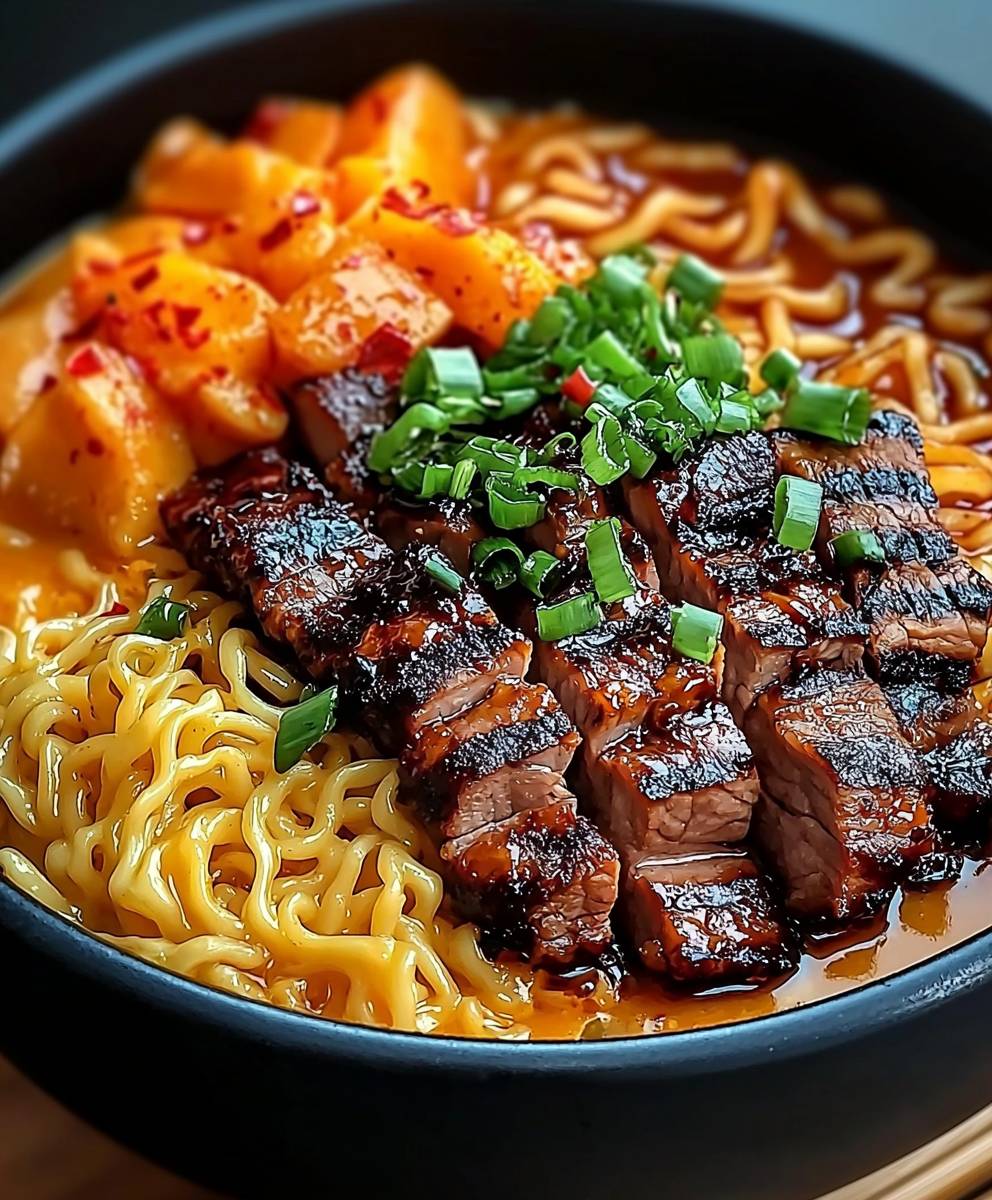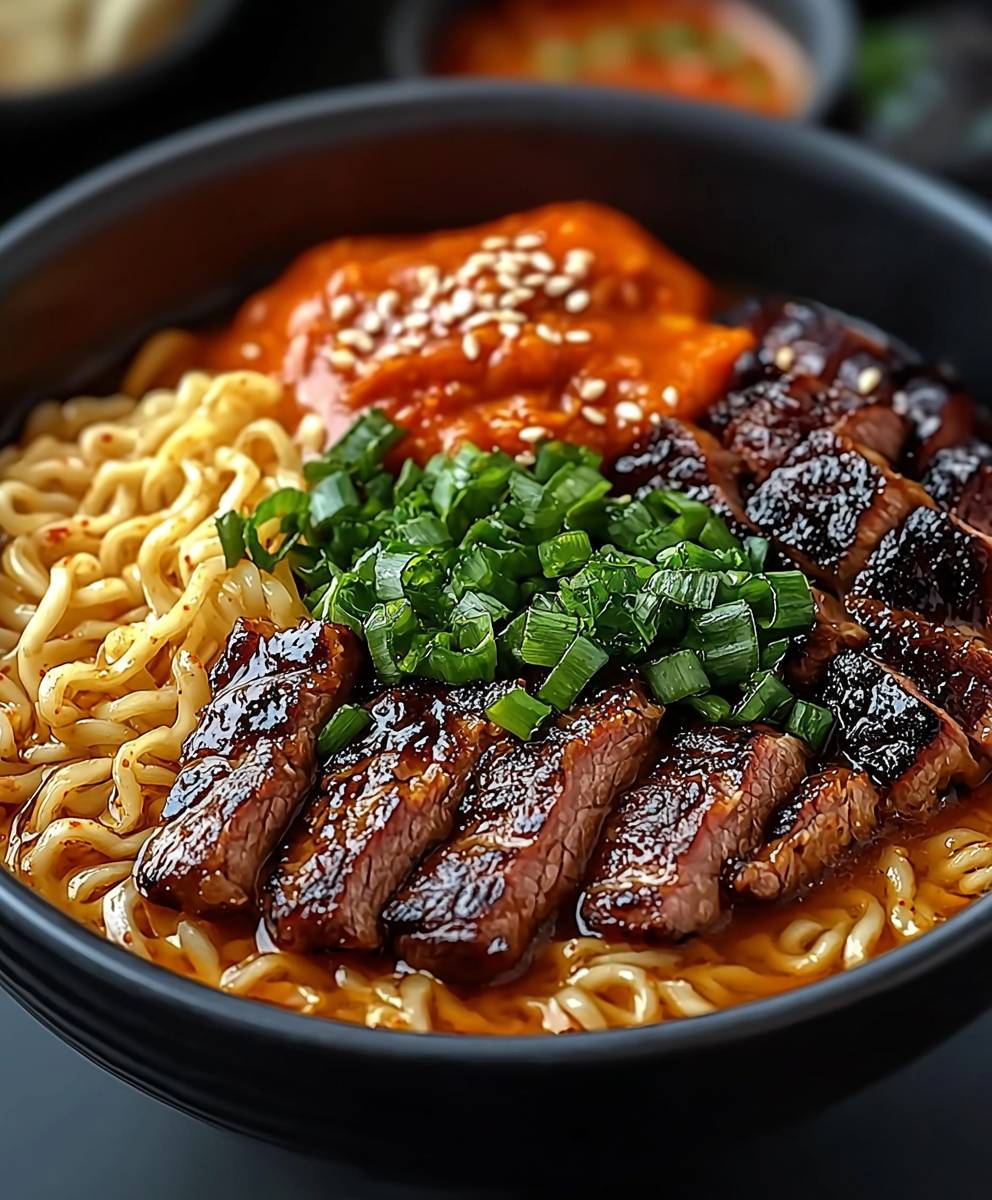Spicy Korean Ramen Beef: Prepare to embark on a culinary adventure that will ignite your taste buds! Forget everything you thought you knew about instant noodles because this recipe elevates humble ramen to a restaurant-worthy masterpiece. Imagine tender, savory beef mingling with the fiery kick of Korean spices, all nestled in a comforting bowl of perfectly cooked ramen noodles. Are you ready to ditch the takeout and create something truly extraordinary in your own kitchen?
Ramen, while often associated with Japan, has deep roots in Chinese noodle dishes. However, Korea has wholeheartedly embraced and adapted ramen, adding its own unique flair with ingredients like kimchi, gochujang, and, of course, generous portions of beef. This particular dish, Spicy Korean Ramen Beef, is a testament to that delicious fusion, blending the convenience of instant ramen with the bold flavors of Korean cuisine.
What makes this dish so irresistible? It’s the perfect balance of textures and tastes. The chewy noodles provide a satisfying base, while the succulent beef adds richness and depth. The spicy broth, infused with Korean chili paste and other aromatic spices, delivers a warming heat that will leave you craving more. Plus, it’s incredibly quick and easy to make, making it the ideal weeknight meal for busy individuals who refuse to compromise on flavor. Get ready to experience a symphony of flavors in every single bite!
Ingredients:
- For the Ramen:
- 4 packets instant ramen noodles (Korean Shin Ramyun recommended for spice)
- 8 cups water
- For the Beef Marinade:
- 1 pound thinly sliced beef (ribeye or sirloin work well)
- 2 tablespoons soy sauce
- 1 tablespoon sesame oil
- 1 tablespoon gochujang (Korean chili paste)
- 1 tablespoon minced garlic
- 1 teaspoon grated ginger
- 1/2 teaspoon black pepper
- For the Vegetables:
- 1 tablespoon vegetable oil
- 1 cup sliced mushrooms (shiitake, cremini, or button)
- 1 cup sliced onion
- 1/2 cup sliced green onions
- 1/2 cup shredded carrots
- 1 cup baby bok choy, chopped
- For the Broth Enhancement:
- 1 tablespoon soy sauce
- 1 teaspoon gochugaru (Korean chili flakes, adjust to taste)
- 1 teaspoon fish sauce (optional, for umami)
- 1/2 teaspoon sugar
- Optional Toppings:
- Soft boiled egg, halved
- Sesame seeds
- Kimchi
- Nori seaweed sheets, cut into strips
Marinating the Beef:
Okay, let’s get started! First, we need to get that beef marinating. This is where the flavor really starts to build, so don’t skip this step!
- In a medium bowl, combine the thinly sliced beef, soy sauce, sesame oil, gochujang, minced garlic, grated ginger, and black pepper.
- Use your hands (or a spoon) to thoroughly mix the beef with the marinade. Make sure every piece of beef is coated.
- Cover the bowl with plastic wrap and refrigerate for at least 30 minutes. Longer is better – even overnight if you have the time! This allows the flavors to really meld together.
Preparing the Vegetables:
While the beef is marinating, let’s prep our veggies. This will make the cooking process much smoother.
- Wash and slice all the vegetables according to the ingredient list. I like to slice the mushrooms and onions thinly so they cook quickly and evenly.
- Set aside each vegetable in separate bowls or containers. This will help you add them to the pan in the right order.
Cooking the Beef and Vegetables:
Now for the fun part – cooking! This is where the magic happens and the delicious aromas start to fill your kitchen.
- Heat the vegetable oil in a large pot or Dutch oven over medium-high heat. Make sure the pot is large enough to hold all the ramen and broth later.
- Add the marinated beef to the pot and cook, stirring occasionally, until browned and cooked through. This should take about 5-7 minutes. Be careful not to overcrowd the pot; if necessary, cook the beef in batches.
- Once the beef is cooked, add the sliced mushrooms and onions to the pot. Cook, stirring occasionally, until the mushrooms are softened and the onions are translucent, about 5 minutes.
- Add the shredded carrots and cook for another 2 minutes, stirring occasionally.
- Finally, add the chopped baby bok choy and cook until it wilts slightly, about 1 minute.
Building the Ramen:
Almost there! Now we’re going to build our ramen masterpiece. This is where we combine everything into one glorious bowl of spicy goodness.
- Pour the water into the pot with the beef and vegetables. Bring the mixture to a boil.
- Once boiling, add the ramen noodles to the pot. Cook according to the package directions, usually about 3-5 minutes. Use chopsticks or a fork to gently separate the noodles as they cook.
- Stir in the soy sauce, gochugaru, fish sauce (if using), and sugar. Taste and adjust the seasoning as needed. If you like it spicier, add more gochugaru. If it’s too spicy, add a little more sugar or soy sauce.
- Stir in the sliced green onions.
Serving and Enjoying:
The moment we’ve all been waiting for! Time to serve up this delicious Spicy Korean Ramen Beef.
- Ladle the ramen and broth into bowls.
- Top each bowl with a soft boiled egg (halved), sesame seeds, kimchi, and nori seaweed strips (if using).
- Serve immediately and enjoy! This ramen is best enjoyed hot, so don’t let it sit for too long.
Tips and Variations:
Here are a few extra tips and ideas to customize your ramen:
- Spice Level: Adjust the amount of gochugaru to control the spice level. Start with a small amount and add more to taste.
- Protein: You can substitute the beef with other proteins like chicken, pork, or tofu. Just adjust the cooking time accordingly.
- Vegetables: Feel free to add other vegetables like bean sprouts, spinach, or bell peppers.
- Broth: For a richer broth, you can use chicken or beef broth instead of water.
- Egg: A soft boiled egg is a classic ramen topping, but you can also use a poached egg or a fried egg.
- Cheese: For a creamy and cheesy ramen, add a slice of American cheese or mozzarella cheese to the bowl before serving. This is a popular variation in Korea.
- Tteokbokki: Add some tteokbokki (Korean rice cakes) for a chewy texture and extra flavor.
Enjoy your homemade Spicy Korean Ramen Beef! I hope you love it as much as I do!
Conclusion:
So, there you have it! This Spicy Korean Ramen Beef recipe is more than just a quick meal; it’s an explosion of flavor that will tantalize your taste buds and leave you craving more. The perfect balance of savory beef, spicy gochujang, and comforting ramen noodles makes this dish an absolute must-try for anyone who loves Korean cuisine or simply enjoys a delicious and satisfying meal. I truly believe this will become a staple in your kitchen, just as it has in mine.
Why is this a must-try? Because it’s incredibly easy to make, packed with flavor, and customizable to your own spice preference. Forget boring weeknight dinners! This recipe elevates the humble ramen noodle into a gourmet experience. The tender beef, infused with the rich and complex flavors of Korean spices, combined with the chewy texture of the ramen, creates a symphony of sensations in every bite. Plus, it’s ready in under 30 minutes, making it perfect for busy weeknights when you need a quick and satisfying meal.
But the fun doesn’t stop there! This recipe is incredibly versatile. Feel free to experiment with different vegetables. Add some sliced mushrooms, bok choy, or even some kimchi for an extra kick. For a vegetarian option, you can easily substitute the beef with tofu or tempeh. Just make sure to marinate it well to absorb all those delicious Korean flavors. You can also adjust the spice level to your liking. If you’re not a fan of intense heat, start with a smaller amount of gochujang and add more to taste. On the other hand, if you’re a spice enthusiast like me, feel free to add a pinch of gochugaru (Korean chili flakes) for an extra fiery kick!
Serving Suggestions and Variations:
- Top with a soft-boiled egg for added richness and protein. The runny yolk adds a creamy texture that complements the spicy broth perfectly.
- Garnish with chopped green onions and sesame seeds for a pop of color and nutty flavor.
- Serve with a side of kimchi for an extra dose of Korean goodness.
- Add a drizzle of sesame oil for a richer, more aromatic flavor.
- For a heartier meal, add some dumplings or mandu to the soup.
- Try using different types of ramen noodles, such as shin ramyun or udon noodles, to change the texture and flavor of the dish.
I’ve poured my heart into perfecting this Spicy Korean Ramen Beef recipe, and I’m confident that you’ll love it as much as I do. It’s a dish that’s both comforting and exciting, familiar yet unique. It’s the perfect way to spice up your weeknight dinners and impress your friends and family with your culinary skills. So, what are you waiting for? Grab your ingredients, put on your apron, and get cooking!
I’m so excited for you to try this recipe! Once you do, please come back and share your experience in the comments below. Let me know what variations you tried, what you loved, and what you would change. I’m always looking for new ways to improve my recipes and learn from my readers. Happy cooking, and I can’t wait to hear what you think!
Spicy Korean Ramen Beef: A Delicious and Easy Recipe
Spicy Korean Ramen with tender marinated beef, vibrant vegetables, and a flavorful broth. A quick and satisfying meal!
Ingredients
- 4 packets instant ramen noodles (Korean Shin Ramyun recommended for spice)
- 8 cups water
- 1 pound thinly sliced beef (ribeye or sirloin work well)
- 2 tablespoons soy sauce
- 1 tablespoon sesame oil
- 1 tablespoon gochujang (Korean chili paste)
- 1 tablespoon minced garlic
- 1 teaspoon grated ginger
- 1/2 teaspoon black pepper
- 1 tablespoon vegetable oil
- 1 cup sliced mushrooms (shiitake, cremini, or button)
- 1 cup sliced onion
- 1/2 cup sliced green onions
- 1/2 cup shredded carrots
- 1 cup baby bok choy, chopped
- 1 tablespoon soy sauce
- 1 teaspoon gochugaru (Korean chili flakes, adjust to taste)
- 1 teaspoon fish sauce (optional, for umami)
- 1/2 teaspoon sugar
- Soft boiled egg, halved
- Sesame seeds
- Kimchi
- Nori seaweed sheets, cut into strips
Instructions
- Marinate the Beef: In a medium bowl, combine the thinly sliced beef, soy sauce, sesame oil, gochujang, minced garlic, grated ginger, and black pepper. Mix well to coat the beef. Cover and refrigerate for at least 30 minutes (or longer, up to overnight).
- Prepare the Vegetables: Wash and slice all the vegetables. Set aside in separate bowls or containers.
- Cook Beef and Vegetables: Heat vegetable oil in a large pot or Dutch oven over medium-high heat. Add the marinated beef and cook, stirring occasionally, until browned and cooked through (5-7 minutes).
- Add the sliced mushrooms and onions to the pot. Cook, stirring occasionally, until the mushrooms are softened and the onions are translucent, about 5 minutes.
- Add the shredded carrots and cook for another 2 minutes, stirring occasionally.
- Finally, add the chopped baby bok choy and cook until it wilts slightly, about 1 minute.
- Build the Ramen: Pour the water into the pot with the beef and vegetables. Bring to a boil.
- Once boiling, add the ramen noodles to the pot. Cook according to package directions (usually 3-5 minutes), separating the noodles as they cook.
- Stir in the soy sauce, gochugaru, fish sauce (if using), and sugar. Taste and adjust seasoning as needed.
- Stir in the sliced green onions.
- Serve: Ladle the ramen and broth into bowls. Top with a soft boiled egg (halved), sesame seeds, kimchi, and nori seaweed strips (if using). Serve immediately.
Notes
- Spice Level: Adjust the amount of gochugaru to control the spice level. Start with a small amount and add more to taste.
- Protein: You can substitute the beef with other proteins like chicken, pork, or tofu. Just adjust the cooking time accordingly.
- Vegetables: Feel free to add other vegetables like bean sprouts, spinach, or bell peppers.
- Broth: For a richer broth, you can use chicken or beef broth instead of water.
- Egg: A soft boiled egg is a classic ramen topping, but you can also use a poached egg or a fried egg.
- Cheese: For a creamy and cheesy ramen, add a slice of American cheese or mozzarella cheese to the bowl before serving. This is a popular variation in Korea.
- Tteokbokki: Add some tteokbokki (Korean rice cakes) for a chewy texture and extra flavor.





